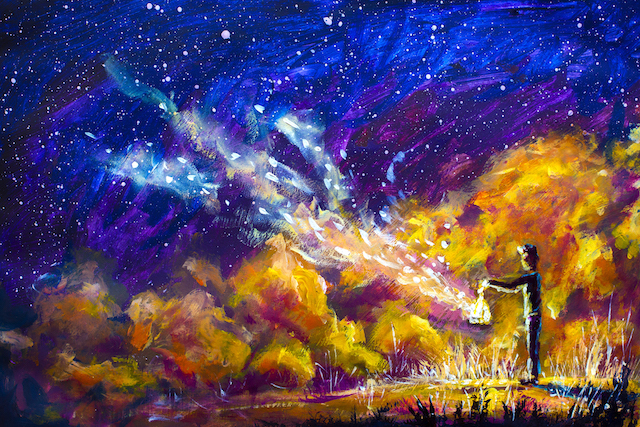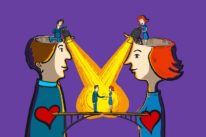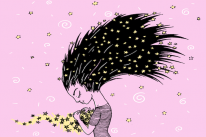
“There is still vitality under the snow, even though to the casual eye it seems to be dead.” ~Agnes Sligh Turnbull
For as long as I can recall, I have always been a fretful and anxious person. Mine was a low-key anxiety that’s always colored the background of my life, a constant companion of ambiguous dread and imminent doom (just around the corner!)
The annoying part was that I never quite knew why the anxiety hung around. There weren’t any real situations in my life that evoked this constant, nagging fear.
I have tried various techniques to manage my anxiety. I tried deep breathing. I tried to balance out the fearful thoughts that sometimes follow the feeling of fear with logical investigation of the facts.
I tried self-hypnosis—imagining a safe place in the depths of my psyche protected by multiple layers of force fields. I tried going toward the fear instead of running from it by putting myself in fear-inducing situations, so I could learn to tolerate it better. I tried self-psycho-analysis.
All these produced various small results, but always, always there was something missing. I somehow felt like I did not go all the way to the bottom of my anxiety.
Then I picked up mindfulness, in those days before it became so well known. I learned on my own and in various courses, to make space for my anxiety.
Above all, I discovered that my anxiety wasn’t me. That was an important piece of the puzzle. And yet, there was still a lot of the puzzle missing. My gut feeling was telling me, there’s got to be more.
And then I came upon a book on Focusing. This is a method discovered by the late psychologist-philosopher Eugene Gendlin. He discovered that people who engaged in a specific kind of internal exploration of their experiences often came away feeling that their emotional struggles have transformed, quite literally.
They no longer felt the same way before they started the internal exploration process. Even though the situation that had caused them to feel that way remained unchanged, how they understood it and felt about it had become radically different.
I was entranced, so I read everything I could about this method. I tried it out on myself…
And fell flat on my face. It didn’t work and I was still anxious. Only now, I was even more anxious because it was tinged with a near panicky sense that what I needed was just within my reach but I could not grasp it! I pictured my anxiety flashing the victory sign in my mind.
Then thankfully, I took a course with a Focusing teacher in the United Kingdom and I got it.
My anxiety started to shift.
How I Understand It: Vital Emotions and Blocks
We are all born with naturally flowing emotions that guide us and give us information about our lives, our worlds, and our needs. I call these “vital emotions.” No matter what form they take (joy, anger, grief, gratitude, and so forth), the experience of them moving within and through us unfettered makes us feel alive.
Just look at babies. They are always experiencing naturally flowing emotions and they are little bundles of vitality. When they are angry, they scream without concern. When happy, their mirth is disinhibited.
However, as we grow up, we learn to cut off these emotions. For instance, some people become overly rational at the expense of feeling emotions, like Sheldon from The Big Bang Theory. Alternatively, some of us fall into stuck emotional patterns that repeat over and over again without getting us anywhere but into trouble (my anxiety is one example).
I call cutting off emotions or stuck emotions “blocks.” We tend to pick them up as we bump along in life. Focusing is a method to help us free up our blocks and get in touch with our vital emotions.
What I Learned About My Emotions
I learned in Focusing to take on a curious and self-compassionate approach to my emotions. I also learned to drop my awareness down into body to experience the sensations of my emotions in real time, and use these sensations to guide my discovery of the layers of information contained within my emotions.
From there, I learned to decode what my emotions are telling me that I needed at that point in time. When I accessed this new understanding, I started to feel my anxiety transform.
When I focused on my anxiety block in an open-minded and compassionate manner, I discovered that it felt like a kind of jittery electricity coursing through my body, and occasionally thickening into a lump in my chest.
Fascinatingly, I also found that I had a tendency to hold back in my actions, my breathing, and even my voice (I had trouble projecting my voice). It was like I had put the brakes on inside myself.
Through gentle and persistent questioning around these bodily responses, I discovered that I picked up my anxiety block because the adults in my life had subtly and not so subtly put me down when I tried to express my vital emotions.
I remembered being shamed for showing my vital emotions like anger or even dizzy joy. Then I was told I was too sensitive when I was feeling vulnerable and upset. My anxiety was telling me that I could not let my guard down. I could not afford to be myself fully.
At this point, my anxiety had started to shift physically and it was replaced by another emotion—sadness. Sadness that I wasn’t allowed to be myself.
As I paid the same gentle attention to how my body held this sadness, it shifted once more and transformed into anger. I was angry that people could do this to me, no matter how well meaning their intentions. How dare they! How could they?
With that line of thought, I knew that I wasn’t going to let people discount my emotions again! I felt physically stronger with this new determination. I had moved pass my anxious block and touched the procession of my vital emotions hiding by it. And then, I realized that my anxiety was trying to protect me from the devastating forces of shame and ridicule. I needed to feel safe in an unsafe environment.
They only way I knew how was to block off my vital emotions least showing them got me into trouble. This realization gave rise to a warm feeling of self-compassion—I was doing the best I could to protect myself and my anxiety was my warning system.
A Realistic Transformative Method
Needless to say, I fell in love with focusing and undertook more training in it. I have found my method of transforming my life-long anxiety. Do I still struggle with it? Of course, but now it feels different. It no longer is a pervasive unknown fear. It has shrunk and only occasionally pops up. And when it does, I know how to engage with it to transform it.
Try This Out
The next time you feel emotionally stuck or have an inexplicable emotional reaction, take a moment to pause and focus on how it feels in your body as a sensation. Notice where in your body you feel it the strongest.
A good place to start noticing is the space within your throat, chest, and belly. Simply spend a minute or two trying to describe the raw sensation of the emotional reaction, in real time—“Right now, how does it feel?” You might notice that the sensation changing. If it does, simple stay on top of it by describing the new sensation.
Simply tuning in this way helps you create a unique and open-minded relationship to your emotions. It is also one of the crucial steps in focusing. See if you could make this into a daily habit. Remember, emotions transform when we try to understand them in an open-minded way.
About Dr. Eric Tan
Dr. Eric Tan is an Australian-Based clinical psychologist who is interested in helping people transform their emotions deeply. His own way of doing Focusing (the Snowflake Method) is distilled in his book (with Dr. Sam Tan) A Little Book on Being Naturally Joyful. Their other book is Dying to Connect But Scared to Death: Moving Beyond Social Anxiety.













 Though I run this site, it is not mine. It's ours. It's not about me. It's about us. Your stories and your wisdom are just as meaningful as mine.
Though I run this site, it is not mine. It's ours. It's not about me. It's about us. Your stories and your wisdom are just as meaningful as mine. 